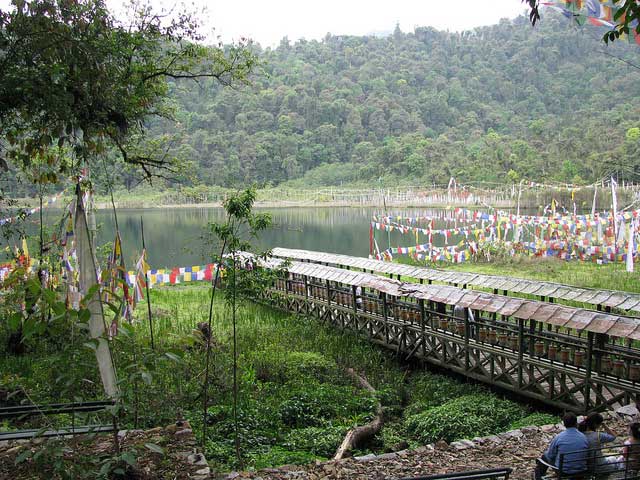Located at an average elevation of 1,700 meters above sea level, Khecheopalri Lake is a sacred place for both Buddhists and Hindus and is situated in the Khecheopalri village in the west Sikkim district. The name of the lake ‘Khecheopalri’ was originally known as ‘Kha-chot-palri’ which means the heaven of Lord Padmasambhava. An interesting feature of the lake is that leaves are not allowed to float on the lake, which is ensured by the birds which industriously pick them up as soon as they drop into the lake surface.
The sanctity of the lake is exemplified by another legend, which says that the shape of the lake is in the form of foot that represents the foot of Lord Buddha, which could be seen from the surrounding hills. The entrance to the lake’s shores is facilitated by a wooden jetty that has prayer wheels, flags and Tibetan inscriptions on its sides leading to the front of the lake where prayers and incense is offered. From the main gate, where there are small shops and road ends to the lake is about a ten to fifteen minutes walk through a lovely tropical forest.
The lake is known as a ‘wish fulfilling lake’ as there are various legends attached to its origin. Consequently, a religious fair, one of the largest festivals in Sikkim, is held here every year for two days in Maghe purne (March/April), which is attended by a large number of pilgrims from all parts of Sikkim, Bhutan, Nepal and India.
They offer food material to the lake and carry waters of the lake as Prasad (substance that is first offered to a deity and then consumed). People believe that Lord Shiva exists in “solemn meditation inside the lake”. During this festival, pilgrims float butter lamps in the lake on bamboo boats tied with khadas (scared scarves), in the evenings chanting prayers as mark of reverence, along with many other food offerings. Chho-Tsho is another festival that is observed here in the month of October after the cardamom harvest to offer gratitude for providing people with food.


